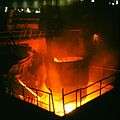Vacuum arc remelting
Vacuum arc remelting (VAR) is a secondary melting process for production of metal ingots with elevated chemical and mechanical homogeneity for highly demanding applications.[1] The VAR process has revolutionized the specialty traditional metallurgical techniques industry, and has made possible incredibly controlled materials used in the biomedical, aviation, and aerospace fields.
Overview
VAR is used most frequently in high value applications. Essentially it is an additional processing step to improve the quality of metal. Because it is both time consuming and expensive, a majority of commercial alloys do not employ the process. Nickel, titanium,[2] and specialty steels are materials most often processed with this method. The conventional path for production of titanium alloys includes single, double or even triple VAR processing.[3] Use of this technique over traditional methods presents several advantages:
- The solidification rate of molten material can be tightly controlled. This allows a high degree of control over the microstructure as well as the ability to minimize segregation
- The gases dissolved in liquid metal during melting metals in open furnaces, such as nitrogen, oxygen and hydrogen are considered to be detrimental to the majority of steels and alloys. Under vacuum conditions these gases escape from liquid metal to the vacuum chamber.
- Elements with high vapor pressure such as carbon, sulfur, and magnesium (frequently contaminants) are lowered in concentration.
- Centerline porosity and segregation are eliminated.
- Certain metals and alloys, such as Ti, cannot be melted in open air furnaces
Process description
The alloy to undergo VAR is formed into a cylinder typically by vacuum induction melting (VIM) or ladle refining (airmelt). This cylinder, referred to as an electrode is then put into a large cylindrical enclosed crucible and brought to a metallurgical vacuum (0.001–0.1 mmHg or 0.1–13.3 Pa). At the bottom of the crucible is a small amount of the alloy to be remelted, which the top electrode is brought close to prior to starting the melt. Several kiloamperes of DC current are used to start an arc between the two pieces, and from there, a continuous melt is derived. The crucible (typically made of copper) is surrounded by a water jacket used to cool the melt and control the solidification rate. To prevent arcing between the electrode and the crucible side walls, the diameter of the crucible is larger than that of the electrode. As a result, electrode must be lowered as the melt consumes it. Control of the current, cooling water, and electrode gap is essential to effective control of the process, and production of defect free material.
Ideally, the melt rate stays constant throughout the process cycle, but control of the process is not simple. Monitoring the vacuum arc remelting process.[4][5] This is because there is very complex heat transfer going on involving conduction, radiation, convection (within the liquid metal), and advection (caused by the Lorentz Force). Ensuring the consistency of the melt process in terms of pool geometry, and melt rate is pivotal in ensuring the best possible properties from the alloy.
Materials and applications
The VAR process is used on many different materials, however certain applications almost always use a material that has been VAR treated. A list of materials that may be VAR treated include:
- Steel
- 9310
- 4340 & 4330+V
- 300M
- 304
- 316
- AF1410
- Aermet 100
- M50
- BG42
- Nitralloy
- 16NCD13
- 35NCD16
- HY-100
- HY-180
- HY-TUF
- D6AC
- Maraging steels
- UT-18
- HP 9-4-30
- Titanium
- Ti-6Al-4V
- Ti-10V-2Al-3Fe
- Ti-5Al-5V-5Mo-3Cr
- Invar
- Nitinol
- Nickel superalloys
- Inconel alloys
- Rene alloys
- RR1000
- Zirconium
- Niobium
- Platinum
- Tantalum
- Rhodium
Note that pure titanium and most titanium alloys are double or triple VAR processed. Nickel-based super alloys for aerospace applications are usually VAR processed. Zirconium and niobium alloys used in the nuclear industry are routinely VAR processed. Pure platinum, tantalum, and rhodium may be VAR processed.
References
- ↑ "Modeling for Casting & Solidification Processing", by Kuang-Oscar Yu,CRC; 1st edition (October 15, 2001), ISBN 0-8247-8881-8
- ↑ D.Zagrebelnyy, Modeling macrosegregation during vacuum arc remelting of Ti-10V-2Fe-3Al alloy ISBN 978-3-8364-5948-8
- ↑ Titanium: Past, Present, and Future (1983) ISBN 0-309-07765-6
- ↑ "Pool Vacuum - Pool Cleaner Reviews 2016". Rexgarden.com. 23 June 2016. Retrieved 26 August 2016.
- ↑ DA Melgaard, RG Erdmann, JJ Beaman, RL Williamson - 2007
